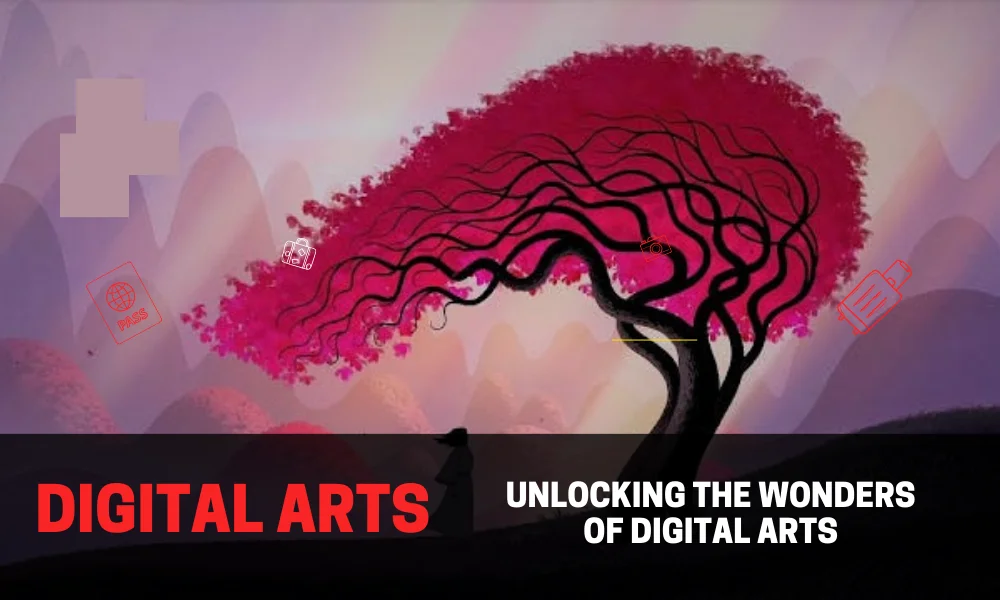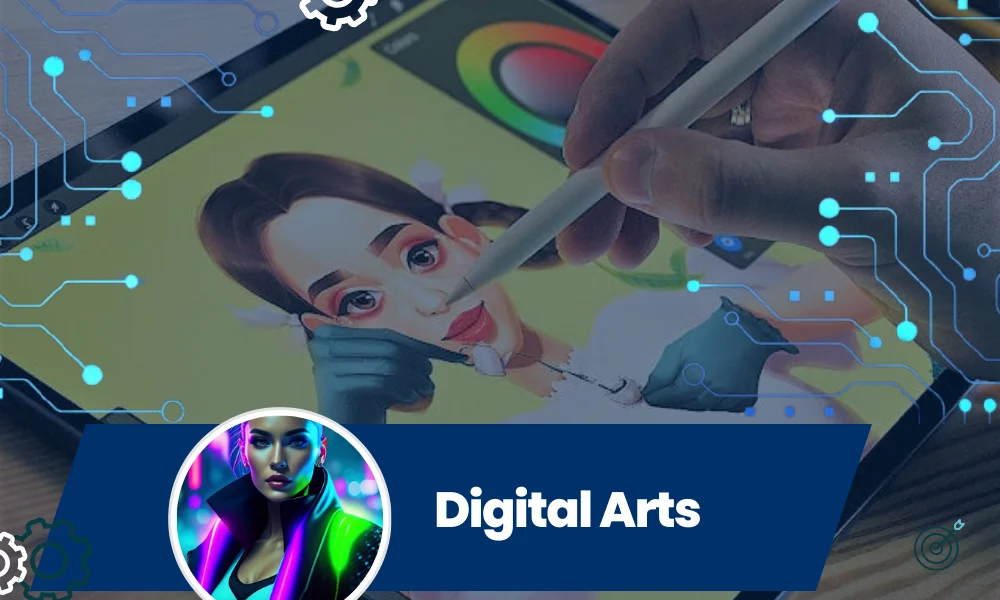Digital Arts
Unlocking the Wonders of Digital Arts: A Comprehensive Guide
The world of art has seen a significant upheaval in the constantly changing digital environment. The field of digital arts has established itself as one that provides a platform for the fusion of creativity and technology.
This exciting and dynamic area has changed the art world and provided new opportunities for artistic expression. In this thorough tutorial, we delve into the world of digital arts, examining its many features, methods, and astounding influence on modern art.
Digital art has developed as a new form of expression in the constantly changing world of art. The digital age and the rise of technology have given artists new and creative ways to express their work.
We will go into the interesting world of digital art in this blog article, looking at its history, methods, and effects on the art world.

Understanding Digital Arts
The broad category of artistic works made with digital technology is known as “digital arts.” Traditional artistic methods and cutting-edge techniques are combined to create works that are both aesthetically striking and thematically rich.
With regards to graphic design, 3D modelling, digital painting, and animation, there are countless ways for artists to realize their thoughts in the digital world.
The Evolution of Digital Arts
Since they first emerged, digital arts have advanced significantly. The initial pixelated images were the beginning, and today it has developed into a complex web of possibilities.
Artists can now produce complex designs and lifelike animations that were previously unthinkable because to the development of powerful software and hardware.
Digital art has its origins in the 1950s, when artists first experimented with using computers to create images. But digital art didn’t start to take off seriously until the 1980s, when personal computers became widely accessible.
With the development of cutting-edge software and graphical tools, artists are now able to produce beautiful works of art on their computer displays.
Artist Harold Cohen, one of the forerunners of digital art, created the AARON programme in the 1970s. The artificial intelligence programme AARON was capable of producing original works of art.
Cohen’s work paved the way for upcoming advances in digital art and encouraged artists to investigate the potential of technology as a medium for expression.
Tools of the Trade
The availability of tools is one of the main causes of the rise in digital arts. There are several software programme available to meet the diverse demands of artists, from Adobe Creative Suite to Blender.
These tools provide artists the freedom to explore new ideas, advance their craft, and experiment.
Digital Art Techniques
Digital Painting
The practice of painting has been transformed by digital technology. With the same level of accuracy as traditional painting, artists can produce works of art on digital canvases.
The benefit? Digital artists may quickly fix errors, try out various styles, and produce several versions of their work.
On a digital canvas, artists can mimic conventional painting techniques using digital painting. Artists can replicate the texture and appearance of oils, watercolors, and acrylics with the use of specialized software and digital brushes. Digital painting has the advantage of being flexible and versatile.
With the ability to quickly experiment with different colour schemes, brush sizes, and layering choices, artists can create spectacular effects and precisely hone their work.
Vector Art
In order to produce shapes and lines in vector graphics, mathematical equations are used. Vector images, as opposed to raster images (pixel-based), are independent of resolution, allowing for image resizing without sacrificing quality.
As a result, vector art is perfect for producing graphics, icons, and logos. Artists and graphic designers utilize well-liked programme like Adobe Illustrator and CorelDRAW to produce eye-catching vector artwork.
Photo Manipulation
Photo manipulation is the process of modifying and improving images to produce inventive and bizarre compositions. Artists can elevate commonplace photographs into remarkable works of art with expert editing.
In digital advertising, movie posters, and book covers, where producing aesthetically pleasing images is essential to grabbing the audience’s attention, photo alteration is frequently utilized.
3D Modeling
Three-dimensional components lend depth and authenticity to artwork. With the use of 3D modelling, artists may produce realistic characters, objects, and situations, which improves the visual impact of their work.
This method is frequently employed in the worlds of architecture, animation, and even video games.
Artists can create three-dimensional characters and things using 3D modelling. These models can then be textured and processed to provide the realistic images frequently used in animation and video games.
The development of 3D technology has enabled artists to produce intricate and lifelike 3D environments that immerse viewers in fantasy worlds.
Graphic Design
Graphic design is an essential component of digital arts because the digital world depends so heavily on images. It entails producing graphics with strong aesthetic appeal for a variety of media, including web design and advertising.
Digital tools are used by graphic designers to create memorable logos, banners, and marketing collateral.
Animation
Digital animation has made new storytelling possibilities possible. Animation brings characters and stories to life in everything from animated films to interactive events.
Animations can be made by artists using programme like Adobe Animate and Toon Boom Harmony that attract viewers.

Digital Collage
To produce visually appealing compositions, digital collages combine different materials like photos, textures, and graphics.
The seamless blending of various materials by artists using layers and blending modes produces attractive and thought-provoking artworks.
The Impact of Digital Arts
A New Era of Accessibility
Art is now more widely available to people because to digital media. A specific studio space or expensive supplies are no longer requirements for artists.
They can produce magnificent works of art from the comfort of their homes with just a computer and the appropriate software.
A wider audience now has greater access to art thanks to the digital medium. Digital tools are frequently more economical than traditional art supplies, and artists no longer need to use pricey materials.
By removing financial constraints, this has democratized art and allowed ambitious artists from all backgrounds to pursue their passions.
Boundless Creativity
Digital arts promote unrestricted creativity. Colours, styles, and techniques can be easily experimented with by artists, encouraging unrestricted creativity. As a result, there has been an explosion of original and cutting-edge artwork that challenges the conventions of traditional art.
Digital Art in Commercial Sectors
Digital arts have an impact beyond of just galleries and shows. They are essential to marketing, entertainment, and advertising. Digital art has impacted our daily lives in a variety of ways that we might not even be aware of, from eye-catching advertising campaigns to visually stunning video games.
Navigating the Digital Arts World
The path starts with getting the necessary tools and mastering the fundamentals if you’re keen to enter the realm of digital arts.
There is always more to learn and discover, whether you are an experienced professional or an aspiring digital artist.
Tips for Beginners
- First, the Foundations: Learn how to use important programme like Corel Painter or Adobe Photoshop.
- Investigate Tutorials: There are a tone of tutorials online that can assist you in understanding both basic concepts and more complex concepts.
- Join groups: Participating in online groups for artists can provide you access to priceless advice and encouragement from other creators.
Advanced Techniques
- Understand Your Tools: To realize the full potential of your chosen software, dig deeper into it.
- Try new things: Don’t be scared to give new approaches a shot. Going against your comfort zone is frequently the source of innovation.
- Ask for Feedback: You can improve your talents by receiving constructive criticism from peers and mentors.
Digital Arts in the Future
Digital art has a bright future as technology develops further. With the prevalence of virtual reality (VR) and augmented reality (AR), artists will have new opportunities to explore and engage their audiences in their works.
Artificial intelligence (AI) development may even result in more complex forms of generative art, where computers and algorithms collaborate with human creators to produce works of art.
NFTs (Non-Fungible Tokens) are gaining popularity, which has given digital artists new opportunities to commercialize their work and receive credit for their contributions.
NFTs give artists the ability to validate and promote their digital works of art as exclusive assets on blockchain platforms, challenging conventional ideas of ownership and value.
The development of digital arts will surely keep pace with the development of technology. We may anticipate ever more lifelike virtual reality experiences, interactive 3D worlds, and cutting-edge art that pushes the frontiers of our imagination.
In conclusion, digital arts are now a major influence in the field of modern art. They have permanently altered the creative landscape and opened up a world of limitless possibilities for artists.
As you begin your trip through the realm of digital arts, keep in mind that there are no restrictions on your creativity in this constantly evolving field of artistic expression.
With technology advancing quickly and artists’ inventiveness growing all the time, the future of digital arts seems to be an exciting voyage into unexplored territory. Here are some intriguing advances and trends to look out for as we go into the future of digital art:
1. Immersive Experiences
Digital arts are poised to produce immersive experiences that will meld the real world with the virtual one. The way we interact with art is about to change thanks to technology like virtual reality (VR) and augmented reality (AR).
Consider experiencing a digital art exhibit or strolling through a virtual gallery where paintings come to life. We may be able to enter the artworks in the future and fully immerse ourselves in them.
2. Artificial Intelligence and Generative Art
In the area of digital arts, artificial intelligence (AI) is becoming increasingly noticeable. Generative art is a new genre that has been created as a result of artists applying AI algorithms to create art.
With the use of algorithms and this innovative method, artists may produce astounding works that would have been impossible to make any other way.
Additionally, AI-driven art has the ability to evolve and react to audience interactions and emotions in real-time.
3. NFTs and Digital Ownership
The way artists sell and purchasers collect digital art has been revolutionized by Non-Fungible Tokens (NFTs), which have swept the art industry by storm.
Artists now have new prospects for financial reward and creative expression thanks to NFTs, which offer a distinctive and unchangeable proof of ownership. With new marketplaces and creative applications of NFT technology, this trend is anticipated to continue evolving.
4. Collaborative Art and Crowdsourcing
Globally collaborative art projects are projected to become more prevalent in digital arts in the future. Digital collaboration allows artists to work together across geographic boundaries to produce works of art.
Through crowdsourcing creativity, a variety of skills can be applied to one piece, producing interesting and varied works.
5. Sustainability and Green Technologies
Digital artists are looking at sustainable practice’s as environmental worries increase. More artists will adopt eco-friendly practices’ in the future, like powering their digital workstations with renewable energy sources and producing artwork with a small carbon imprint.
6. Blockchain and Art Provenance
Blockchain technology will keep improving digital art’s validity and provenance. Artists and collectors can prevent against theft and fraud by keeping a clear and unalterable ledger of each artwork’s journey by securely documenting its past.
7. Interactive and Responsive Art
Digital arts will become more interactive and viewer-responsive. Think about interactive art pieces that respond to your feelings or motion-responsive digital sculptures.
The potential for developing dynamic, interesting, and unique creative experiences is limitless.
8. Cross-Disciplinary Fusion
The lines separating various fields and art forms will keep blending. Music, literature, science, and technology will all be combined by digital artists to produce multidimensional works that defy conventional classification.
The revolutionary art forms that result from these interdisciplinary collaborations will challenge our preconceptions.
The only thing that is consistent in the world of digital arts is change. The future promises to be a fantastic trip full of amazing breakthroughs as technology and creativity continue to push the limits of what is possible.
Digital art has no boundaries and offers limitless options for research and expression, so artists, collectors, and aficionados may all look forward to a world where it is unrestricted.
Conclusion
In conclusion, digital art has become a potent force that is changing how audiences view art and how artists express their creativity. Digital art is surely here to stay given its ever-expanding capabilities and growing effect on numerous industries.
We are continually in awe of the digital marvels created by artists, whether it be through digital painting, picture manipulation, or 3D modelling.
So enter the intriguing realm of digital painting, where imagination has no boundaries and the virtual canvas is a limitless playground. Witness how digital art is influencing the future of artistic expression as you embrace the combination of art and technology.
Digital art will continue to develop as new tools and technologies are developed, inspiring future generations of artists.

